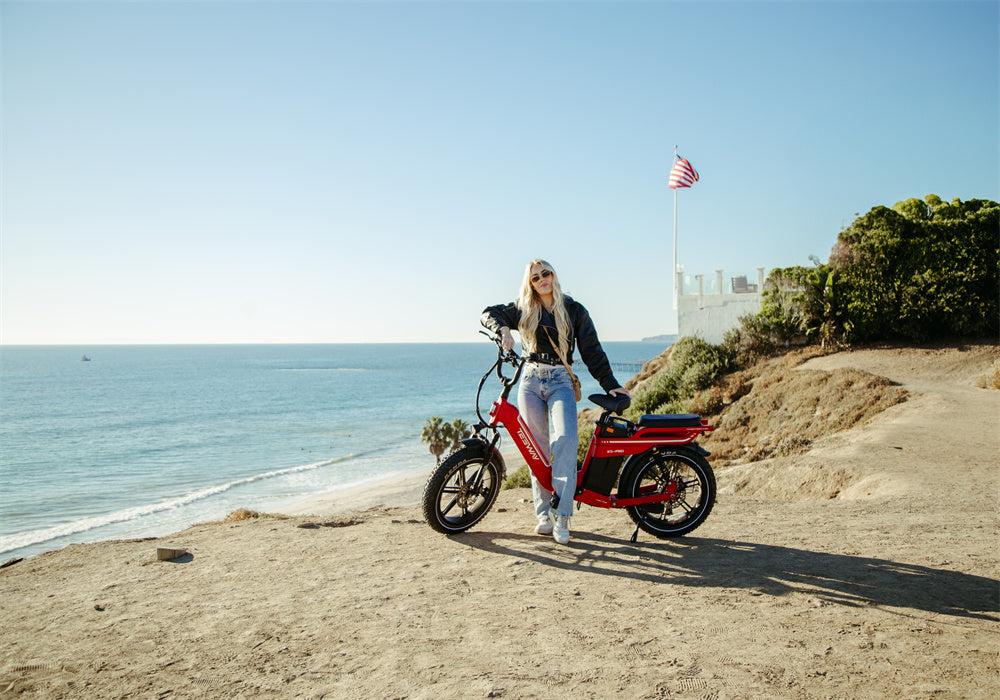The front derailleur plays a critical role in the smooth shifting and overall performance of your electric bike.
A properly adjusted derailleur ensures that you can shift gears seamlessly, preventing the chain from skipping or dropping.
Checking and maintaining your front derailleur regularly is essential to keep your electric bike performing at its best, whether you're tackling steep hills or cruising through flat terrain.
Here's a step-by-step guide to checking your front derailleur on electrical bike to ensure optimal function.
1. Inspect the Front Derailleur's Alignment
Start by inspecting the front derailleur's position relative to the chainrings. The derailleur should sit parallel to the chainrings and be positioned approximately 1-2mm above the largest chainring. If it's too high or too low, it can result in poor shifting or chain drop.
Steps:
-
Shift to the smallest chainring and the smallest cog at the rear.
-
Check the gap between the derailleur and the chainring. It should be even across the entire length of the derailleur.
-
If the derailleur is misaligned, use a 5mm Allen wrench to adjust the mounting bolt, bringing it into the proper position.
2. Verify the Front Derailleur's Cable Tension
Cable tension is critical for precise shifting. If the tension is too loose or too tight, the derailleur won't move accurately between gears. To check and adjust cable tension:
Steps:
-
Shift to the largest chainring and the largest cog at the rear.
-
Inspect the movement of the derailleur. It should move smoothly and without hesitation.
-
If the derailleur struggles to shift into the larger chainrings, the cable tension might be too loose. If it shifts too quickly or jumps gears, the tension could be too tight.
-
Adjust the tension using the barrel adjuster near the shifter or on the derailleur itself.
SEE ALSO How to Adjust the Rear Derailleur on an E-Bike
3. Check for Chain Rub and Chainline Issues
One common problem with electric bikes, especially when using a mid-drive motor, is chain rub. Chain rub occurs when the chain comes into contact with the front derailleur cage while riding. This issue usually arises when the derailleur is out of alignment or if the cable tension is too high.
Steps:
-
Shift through all the gears, paying attention to any rubbing noises.
-
If you hear chain rub, it may be a sign of improper alignment or excessive chain tension.
-
Recheck the derailleur’s position and adjust the tension as needed.
-
Ensure the chainring teeth are not damaged or excessively worn, as this can cause uneven shifting and rubbing.
4. Examine the Derailleur for Wear and Tear
The front derailleur is exposed to a variety of elements, including dirt, water, and road debris. Over time, wear and tear can cause the derailleur to lose its effectiveness. Regular inspection is crucial to ensure that all parts are functioning correctly.
Steps:
-
Inspect the derailleur for signs of physical damage, such as dents, cracks, or bent components.
-
Check the cage for any signs of bending or twisting. A bent cage can cause erratic shifting or prevent the derailleur from shifting smoothly.
-
Inspect the jockey wheels for any wear. These small wheels guide the chain as it moves through the derailleur. Over time, they can wear down or become stiff, which can affect the derailleur's performance.
5. Test the Shifting Performance
Now that the front derailleur is properly aligned and tensioned, it’s time to test its performance. Testing the derailleur will help ensure that the bike shifts smoothly under load and that the derailleur is functioning as expected.
Steps:
-
Ride the bike in different gears, focusing on shifting between the chainrings.
-
Pay attention to how the bike shifts from the smallest chainring to the largest and back again.
-
If you experience sluggish or delayed shifting, recheck the cable tension and derailleur alignment.
6. Ensure Proper Lubrication of the Derailleur Mechanism
The front derailleur mechanism includes a number of moving parts that need proper lubrication to function smoothly. Without adequate lubrication, shifting can become sluggish, and the derailleur may wear out faster.
Steps:
-
Apply a small amount of lubricant to the pivot points of the derailleur, especially the main pivot and the jockey wheels.
-
Avoid over-lubricating, as excess oil can attract dirt and debris, which can hinder the derailleur’s movement.
-
Clean the derailleur and chain regularly to prevent buildup of grime and rust.
7. Check for Proper Chain Length
The length of your chain can also affect the performance of your front derailleur. If the chain is too long or too short, it can interfere with the derailleur’s ability to shift smoothly between the chainrings.
Steps:
-
Shift to the largest chainring and the largest cog on the rear wheel.
-
Check the position of the derailleur. It should be able to shift into the largest chainring without overstretching or binding.
-
If the derailleur has trouble reaching the large chainring, it may be a sign of an incorrectly sized chain. In this case, remove the chain and adjust its length according to the manufacturer’s specifications.
Conclusion
Maintaining the front derailleur of your electric bike is essential to ensure smooth and efficient gear shifting, preventing costly repairs down the road.
Regularly inspect the alignment, cable tension, wear and tear, and lubrication of the derailleur to keep your bike shifting smoothly.
FAQs
How often should I check my front derailleur on an electric bike?
You should check your front derailleur at least once every month or after every long ride, especially if you're riding in harsh conditions like mud or rain. Regular checks will ensure that shifting is smooth and efficient.
What can cause my front derailleur to skip gears?
Gear skipping can occur due to issues with cable tension, derailleur alignment, or a worn-out chain or cassette. Check the alignment, adjust the cable tension, and replace any worn components as needed.
Can I fix my front derailleur myself, or should I take it to a mechanic?
If you're comfortable with basic bike maintenance, you can likely adjust the front derailleur yourself. However, if you're unsure or if the issue seems more complex (like bent derailleur hangers), it’s best to consult a professional bike mechanic.








Share:
Can You Ride an Electric Bike Without Pedaling at All?
Can Ebike Go 100 Miles?